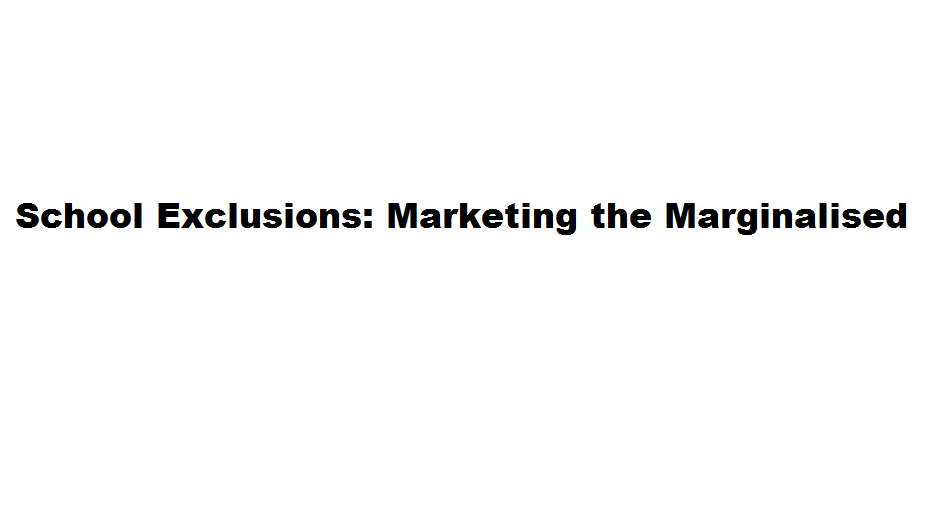Recent initiatives on school exclusions miss the point, ‘alternative provision’ has been transformed into a business opportunity.
According to A. Sivanandan, ‘the adult occupies the world of the child far more than the child occupies the world of the adult.’ [1] Nowhere is this statement truer than in the realm of education. The British education system makes or breaks poor working-class children. The ones who just about survive generally achieve five GCSEs (previously at grade C, now grades 4 or 5) at key stage 4, the supposed golden ticket into the world of work, even if that work is precarious and low paid. While the rest, the broken, those who are routinely excluded or permanently expelled, leave school with nothing. The only golden tickets these young people will go on to hold are scratch-cards. A gambling analogy is not far-fetched. Access to a good, meaningful and inclusive education is a postcode lottery as the practice of exclusions is heavily concentrated in cities. What is more, the geography of British school exclusions tells us that young Londoners are at higher risk of exclusion and entering the ‘alternative provision system’.
The failings of the Timpson Review
 Privately educated former Conservative MP, Edward Timpson, was recently commissioned by the government to explore the practice of school exclusions in England. In particular, he was tasked with digging into racial disparities; ‘why some groups of children are more likely to be excluded including … children from particular ethnic groups’. The specificity of the task was launched in response to findings from the Race Disparity Audit, but despite this, as the Runnymede Trust pointed out, the review did very little to update already existing knowledge, that black Caribbean boys and Gypsy, Roma and Traveller children are at the sharpest end of exclusionary practices across the country. [2] And the report’s recommendation that the education sector and those affiliated to it should ‘collect and share data to help understanding of how exclusion is used in local areas, assess and act to reduce disparities, with particular reference to certain ethnic groups’ also falls seriously short of addressing the issue. For families on the front line, dealing with increasingly neoliberal, marketised and ultimately, tyrannical education policies [3], which disproportionately affect racialised communities, Timpson’s review is just another example of the government paying lip service to a problem.
Privately educated former Conservative MP, Edward Timpson, was recently commissioned by the government to explore the practice of school exclusions in England. In particular, he was tasked with digging into racial disparities; ‘why some groups of children are more likely to be excluded including … children from particular ethnic groups’. The specificity of the task was launched in response to findings from the Race Disparity Audit, but despite this, as the Runnymede Trust pointed out, the review did very little to update already existing knowledge, that black Caribbean boys and Gypsy, Roma and Traveller children are at the sharpest end of exclusionary practices across the country. [2] And the report’s recommendation that the education sector and those affiliated to it should ‘collect and share data to help understanding of how exclusion is used in local areas, assess and act to reduce disparities, with particular reference to certain ethnic groups’ also falls seriously short of addressing the issue. For families on the front line, dealing with increasingly neoliberal, marketised and ultimately, tyrannical education policies [3], which disproportionately affect racialised communities, Timpson’s review is just another example of the government paying lip service to a problem.
Where do the excluded go?
Theresa May’s ‘indictment’ in 2016, that the ‘burning injustice’ of racialised school exclusions was preventing Britain from ‘transform[ing] into a Great Meritocracy’ has left working-class parents and young people screaming into the void. The issue of school exclusions, is not limited to who is being excluded, but also, where the excluded are sent and the impact this has on their lives. May might have talked convincingly about the ‘scandal’ of the British education system, but it is on her watch that we have seen the significant expansion of the alternative provision sector.
Over the past three years, the sheer number of children that have been removed from mainstream schooling has soared. An investigation conducted by Schools Week found that local authorities up and down the country have increased spending on privatised alternative provision, with an extra £7 million being siphoned off from diminished council budgets between 2016 and 2019. ‘Last year Ofsted also warned MPs’, argues Schools Week, ‘that private companies were profiting by offering illegal AP [alternative provision] that gave pupils “a very limited educational experience.”’ What we are witnessing is a small sector being transformed into a system – the ‘alternative provision system’ – that is increasingly influenced by the market and privatised. And, with this going on behind closed doors, we should think carefully before blindly welcoming recent parliamentary and think-tank expressions of interest in addressing school exclusions, and consider what future government policies may be adopted in their wake.
What is next for alternative provision?
 In 2017, think tank The Institute of Public Policy Research (IPPR) published Making the Difference: Breaking the Link Between School Exclusion and Social Exclusion, in which the case was made that redesigning the alternative provision sector would address ‘Britain’s social mobility failure’. On the back of the report, a new charity The Difference was launched earlier this year, to ‘improve the outcomes of vulnerable children by raising the status and expertise of those who educate them’ (read Oxbridge and Russell Group graduates). While hiring very privileged graduates to teach society’s most marginalised young people is problematic in itself, in that they are unlikely to stay [4], we should also be concerned about other, less overt issues.
In 2017, think tank The Institute of Public Policy Research (IPPR) published Making the Difference: Breaking the Link Between School Exclusion and Social Exclusion, in which the case was made that redesigning the alternative provision sector would address ‘Britain’s social mobility failure’. On the back of the report, a new charity The Difference was launched earlier this year, to ‘improve the outcomes of vulnerable children by raising the status and expertise of those who educate them’ (read Oxbridge and Russell Group graduates). While hiring very privileged graduates to teach society’s most marginalised young people is problematic in itself, in that they are unlikely to stay [4], we should also be concerned about other, less overt issues.
To start with, the IPPR in its report boasted, ‘some of England’s largest multi-academy trusts have already endorsed the development of The Difference and expressed a desire to partner with the programme’. Multi-academy trusts (a conglomerate of schools) epitomise the neoliberal turn in British education, hallmarked by parlous deregulation and opaque policies that allows a good many of Britain’s ‘schools’ to be run as businesses for private profit. The irony is that IPPR critiqued the then current alternative provision sector for exactly the same problems (lack of regulation, unclear policies etc.) that multi-academy trusts are known for!
But endorsement for The Difference has also come from cross-party politicians, including the House of Commons Education Committee and Edward Timpson, with the former saying in a recent report ‘we consider that the work by The Difference is a step towards improving relations between mainstream schools and alternative provision’, and the latter writing the preface to the IPPR report. While these may suggest that politicians are taking the education of excluded children seriously, we should be wary this does not turn into just another opportunity to subcontract the management of serious social problems out to the private sector. In fact, a senior educator at a Pupil Referral Unit (PRU) in London warned IRR News in a discussion that ‘the increased scrutiny of PRUs is linked to the potential academisation, and therefore privatisation of the alternative provision system’.
Alternative provision in London
Another, arguably more acute issue is the increasing size and influence of the alternative provision system in London. With young people in London expelled from mainstream schooling at almost double the national rate we have to ask ourselves why is this specific to London? In terms of policy and legislation changes in mainstream schooling, there were two key moments. The introduction of the London Challenge, a school improvement programme that was launched under New Labour in 2003, aimed at increasing the performance of London secondary schools. [5] Then subsequent changes made by the Conservative-Liberal coalition government which passed the Academies Act 2010 made it easier for all publicly funded schools in England to become private academies. While no statistics are available on the number of London schools that have been converted into academies, any Londoner will tell you that they now dominate the capital’s educational provision. (What happened to free market choice?) Furthermore, since academies are not beholden to local government and enjoy greater administrative autonomy over matters of spending, teaching and organisation, this has also given rise to a wider do-as-you-like culture, allowing them to exclude and off-roll pupils at will.
With mainstream schools now judged almost exclusively on their examination results, this system produces winners and losers, and the losers are almost always poor children, seen to possess no academic value in an increasingly marketised education system. So what happens to them? They are abandoned. Sent to the lower sets, excluded, expelled and then carted off to alternative provision, where they are said to ‘underachieve [in their GCSEs] on a spectacular scale’. The disposability of working-class children’s education is scandalous, but it does not stop there.
Educational disenfranchisement, knife crime and imprisonment
London Mayor Sadiq Khan, has recently, in the context of a rise in the capital’s knife crime, condemned the government for failing to fully acknowledge the impact that the practices of school exclusions and off-rolling are having on serious violence in the capital, attributing ‘a fragmented education system in which local authorities have little control over academies and free schools’ as a significant factor. Knife crime has not appeared out of thin air, it is the manifested violence of the violated. A violence born out of deprivation, desperation and defilement. Dispossessing a great swathe of young people of their right to a proper mainstream education runs in tandem with the politics of our time that is producing a highly disenfranchised surplus population.
It is no mere coincidence that 89 per cent of ‘imprisoned’ young people (aged 12-18) in Britain have reported being excluded from school. [6] The writing is on the wall: exclusions, compounded by alternative provision, fuel serious youth violence, which, in turn, leads to higher rates of incarceration. But who is being locked up? Predominantly, poor black, Asian and minority ethnic boys. In January 2019, Her Majesty’s Inspectorate of Prisons found 51 per cent of boys in young offender institutions and 42 per cent of children in secure training centres were from BME backgrounds. [7] It is worth remembering that the proportion of incarcerated BME young people is almost four times the proportion of the UK’s entire BME population (14 per cent). [8]
The government is making a weak attempt at the moment to examine school exclusions as a catalyst for serious youth violence and knife crime, often resorting to semantic debates about ‘causation’ and ‘correlation’. Whether it is causal or correlative is neither here nor there; we know there is a deleterious connection. Facile explanations are not wanted by parents and young people. A recent reminder from London-based Drill artists Skengdo & A.M and Drillminister of a cross-section of state failings: ‘how they [the government] gonna ask what the ends need? Then after, they don’t do a thing. Then they wanna act all clueless…’. [9]


Greetings
This revelation is not something new, which ha sjust been discovered. For decades now private enterprises are receiving lucrative contracts for unfit for purpose alternate services. As a result of illegal school exclusions.
Which consistently place our Futures at risk from Tribalism/ radicalization, and If we are to believe the media ,more increasingly,incidents of Knife Crime.
Given the majority are of African Caribbean Children ( male) more increasingly girl children.
This pandemic places this protected group into
https://bit.ly/2Kp0Svu (T.S.P.P). Moreover dont we need we need to seriously examine, any links to exclusions and the soaring reports of knife crime… How school discipline primes the school to prison pipeline for young African Caribbean Futures. Who the majority of these contractors are, If the majority of they offer value for money, are there productive outcomes for the Futures at risk , and if not, why do they consistently win contracts.
Monitoring and evaluation seems very limited, a the time of writing this response , I was not able to locate any body which provides this essential data. Even so this is in effect pimping of the vulnerable for monetary purposes.
For any other demograph this would be unacceptable, so why are we not outraged,demanding accountability,and a timely response to these unacceptable situations.